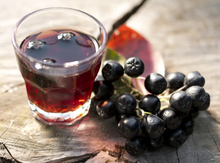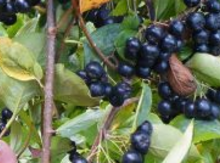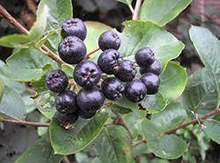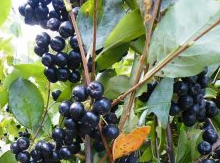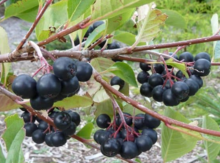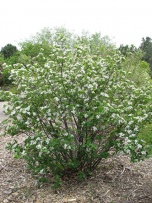
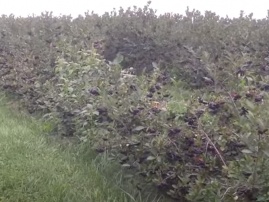
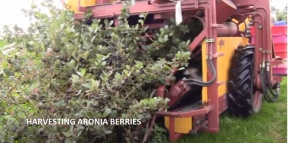
Aronia Berry
The aronia, Aronia melanocarpa, is native to Eastern North America. The fruit, leaves and twigs were used by the indigenous people for medicinal purposes. Also known as chokeberries, the fruit never became popular with settlers in North America. It was introduced to Europe in the 1900's and the dried fruit and juice became an export market for Poland, and ironically back to North America. The aronia fruit is well known as a superfood since it is high in vitamin C and very high in antioxidants. Agricultural scientists in Finland discovered that making jam from the berries was the best way to retain antioxidants compared to drying the fruit or juicing it.
The fruit is astringent (mouth-puckering), so most people do not enjoy eating it fresh. However, if you mix aronia berries 1:1 with a sweeter fruit (Blueberry? Raspberry? Apple?), you’ll enjoy them very much in juice, wine, baking, jams and jellies, or in fruit smoothies. Frozen berries can be used all year round as you would use blueberries.
Aronia is a self-fertile plant and bears from the 2nd year of growth. The ripe Aronia berries can be harvested from the end of August/beginning of September, when the berries are black-red on the inside. The plant grows to about 1.5 m (5ft). It is hardy to zone 3.
Aronia Berries are the most vitamin-rich and healthiest of all berries! Up to 1000 milligrams of antioxidant anthocyanins are contained in 100 grams of freshly harvested fruits. Native to Eastern North America, Black Chokeberry thrives in low woods, swamps and bogs. Our aronia seedlings are grown from seed. Hardy for zones 3 to 8.
‘Viking’ aronia, a cultivar from Finland, is produced from cuttings so it is on its own roots. It shows attractive clusters of white flowers in late spring, followed by clusters of ripe fruit in early September. In the fall, the leaves turn a vibrant reddish-orange colour. It can be grown as a specimen plant, a hedge or a potted plant. Hardy for zones 3 to 8.
‘McKenzie’ cultivar has been selected for its shelterbelt (windbreak) properties. At 3 m tall (10 feet), 'McKenzie' Black Chokeberry makes a very efficient windbreak. It produces large, black, juicy fruits that can be eaten fresh, or used with plums to make a wonderful jam. In the fall, the leaves turn a reddish-orange colour. Hardy for zones 3 to 8.
'Nero' Aronia fruit weight from 1 to 1.5 gram per berry, and are very rich in antioxidants. Studies are showing wide-spread health benefits. Aronia melanocarpa ‘Nero’ reaches up to 1.8 m (6 ft) tall. Being 2 feet shorter than the variety, ‘Viking’ (8 ft), Nero fruits are easier to pick without using a ladder! In the fall, the leaves turn a vibrant reddish-orange colour. Hardy for zones 3 to 8.



